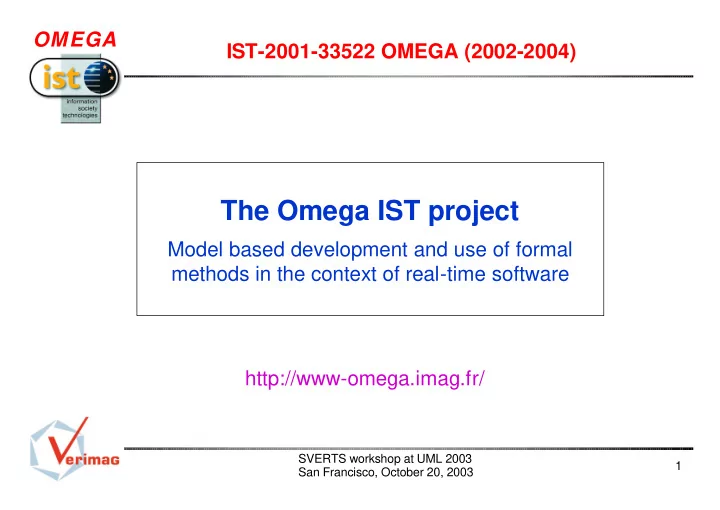

OMEGA IST-2001-33522 OMEGA (2002-2004) IST-2001-33522 The Omega IST project Model based development and use of formal methods in the context of real-time software http://www-omega.imag.fr/ SVERTS workshop at UML 2003 1 San Francisco, October 20, 2003
OMEGA Partners IST-2001-33522 Academic (tool and technology providers) � Verimag, France – coordinator � Christian-Albrechts University Kiel, Germany � CWI (Centrum voor Wiskunde en Informatica), Netherlands � University of Nijmegen, Netherlands � OFFIS, Germany � Weizmann Institute, Israel Users � EADS Launch Vehicles, France � France Telecom R&D, France � Israeli Aircraft Industries, Israel � NLR (Nationaal Lucht- en Ruimtevaartlaboratorium), Netherlands Supporters (CASE tool providers) I-Logix --- Rational Software, IBM --- Telelogic SVERTS workshop at UML 2003 2 San Francisco, October 20, 2003
Model based development in the context OMEGA IST-2001-33522 of real-time and embedded systems General ideas and derived requirements: � A model integrating different aspects of the system (and its environment) � Possibility to represent different aspects of heterogeneous systems � Maintenance of a consistent model throughout the development � A semantic framework consistently integrating all aspects � Early detection of design errors by realistic simulation and testing at early stages of design � Existence of an operational semantics even for abstract high level models � Take into account non functional aspects early � Early formal validation SVERTS workshop at UML 2003 3 San Francisco, October 20, 2003
OMEGA Analysis of real-time systems today IST-2001-33522 Current practice in a model-based approach (oversimplified): Step 1 : Build a functional model, analyse and refine it until stable Step 2 : Independently (or almost) of the functional model, build a task model and do timing analysis based on simulation or analysis tool (mainly RMA) Problems : � risk of inconsistency between functional and task model � if time analysis reveals problems, step 1 has to be started all over again � modification in step1 of the models increases the risk of introducing inconsistency SVERTS workshop at UML 2003 4 San Francisco, October 20, 2003
Development and verification in a model OMEGA IST-2001-33522 based approach Step 1 : Build an initial model of the system and its environment including both functionality and relevant timing information Step 2 : Extract several models and analyze them using formal techniques: � A model focussing on functional correctness: use untimed verification to detect deadlocks, unreachable states, … � A model focussing on timing : use timed verification tools to detect timing errors, race conditions, … � … Step 3 : Modify and refine the initial model, verify refinement formally, and redo step 2 SVERTS workshop at UML 2003 5 San Francisco, October 20, 2003
OMEGA Formalisms for expressing real-time IST-2001-33522 Verification methods and tools for real-time systems developed by the formal methods community � Good semantic level formalisms for the representation of models including timed aspects (extensions of timed automata, …) � Verification and analysis tools for these formalisms (symbolic analysis, model exploration based analysis, theorem proving) Problem : low level representation of real-time systems, � convenient for representing some extracted model for timed verification � not convenient for modeling time at user level SVERTS workshop at UML 2003 6 San Francisco, October 20, 2003
OMEGA Problems addressed in OMEGA IST-2001-33522 Modelling real-time and embedded systems in UML Problem : UML lacks sufficiently expressive notations � for the definition of a functional model of a software system and its environment including heterogeneous components (different execution and communication modes) � for defining time extensions � for the expression of requirements to be verified on the model (functional and time related properties) . . . and especially the meaning of notations SVERTS workshop at UML 2003 7 San Francisco, October 20, 2003
OMEGA Problems addressed in OMEGA IST-2001-33522 Verification of UML models � Problems related to UML � Lack of a consistent semantic model for different UML notations � Problems related to existing verification methods and tools � Some UML concepts cannot be expressed in the formalisms of existing validation tools (dynamic systems, inheritance, …) � Existing validation methods can not deal with these concepts efficiently (scalability) � Compositional and abstraction based methods must be further developed SVERTS workshop at UML 2003 8 San Francisco, October 20, 2003
OMEGA Problems addressed in OMEGA IST-2001-33522 Make results available to users of UML CASE tools � Problems related to deficiencies of UML and Case tools � XMI is the standard model exchange format for UML, but � It does not cope for all parts (action language, OCL) � XMI export is not provided by all tools, and some concepts are represented differently by different tools � CASE tools do not implement all notations or impose restrictions on their use � Problems related to semantic differences with existing case tools � Some case tools have nice facilities for interactive model exploration, but they are based on a particular tool semantics SVERTS workshop at UML 2003 9 San Francisco, October 20, 2003
OMEGA Omega project: a proof of concept IST-2001-33522 1. A subset of UML notations for the representation of models (class diagrams, state charts, architecture and component diagrams, real-time profile) and requirements (LSC, OCL) � Extensions for sufficient expressive power � A semantics integrating all notations consistently 2. Adaptation of existing validation tools for the validation of UML models by mappings from UML (XMI) into input format of the existing tools by respecting the defined reference semantics � Extensions of internal formalisms to cope with the expressive power of UML � Improvement of existing validation methods � Development of compositional verification methods based on the components concept 3. A methodology for the use of the defined notations and tools 4. Evaluation of the developed tools and methods by means of case studies provided by industrial users SVERTS workshop at UML 2003 10 San Francisco, October 20, 2003
Recommend
More recommend